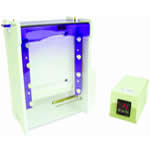■ Maximum 96-sample throughput
■ Large format – 20 x 20cm glass plates
■ Use with 100ml gradient mixer to make two 1mm parallel denaturing gradient gels
■ Compatible with microplates and thermal cycler blocks
The omniPAGE-DGGE denaturing gradient gel electrophoresis unit can run two 20 x 20cm polyacrylamide gels for the detection of single base changes and polymorphisms in cloned or amplified DNA fragments. It is ideal for the study of mutations and DNA polymorphisms critical in disease. This system is primarily for parallel denaturing gradient electrophoresis. The full range of "DGGE" analysis can be performed in this unit. During Denaturing Gradient Gel Electrophoresis,
"DGGE", the buffer in the unit is heated using a 400-watt heater and the temperature controlled by an external temperature control connected to an internal sensor. This allows the gel temperature to be set to the melting temperature (Tm) of the amplified DNA polymorphism mutation of interest.
The temperature can be adjusted in 1°C increments up to a maximum temperature of 70°C, so the full range of DGGE analysis can be performed in this unit. The unit contains all the features of the successful omniPAGE series and uses the same user-friendly gel casting system. OmniPAGE-DGGE uses all combs and accessories of omniPAGE Maxi, shown on page 24.
Peristaltic pumps
Available in single, dual and tetrad formats these versatile peristaltic pumps are an ideal accessory for gradient gel formation with the VS20-DGGE. The ‘easy load’ head of the MU-D01 single peristaltic pump accommodates multiple tubes of different diameters offering the user enhanced flexibility in flow rate selection, while the MU-D02 single pump has the added benefit of a more powerful pump motor. The MFU-01 and MFU-02 dual and tetrad pumps are equipped with microprocessor technology for more accurate rpm control, and comprise 2 and 4 peristaltic pumps respectively that may be controlled individually. All 4 pumps are reversible and have a small footprint, occupying minimum space within the laboratory. Other applications include: filtration, sampling, chemical spraying, dispensing, transferring, feeding and filling.
